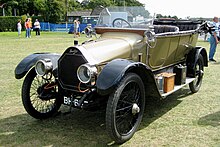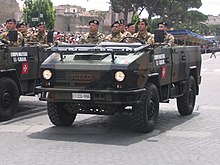


The torpedo body style was a type of automobile body used from 1908 until the mid-1930s, which had a streamlined profile and a folding or detachable soft top. The design consists of a hood or bonnet line raised to be level with the car's waistline, resulting in a straight beltline from front to back.[1]
The name was introduced in 1908 when Captain Theo Masui, the London-based importer of French Gregoire cars, designed a streamlined body and called it "The Torpedo".[2]
The Torpedo body style was usually fitted to four- or five-seat touring cars (cars without a fixed roof) with detachable or folding roof, and low side panels and doors. Torpedo cars did not have B pillars, so the only uprights present were those supporting the windshield.
Similar styles are phaeton and baquet.[3]
The name is also used for trucks with a hood or bonnet.[4][5]
- ^ Roberts, Peter (1974). "Carriage to Car". Veteran and Vintage Cars. London, UK: Octopus Books. p. 111. ISBN 0-7064-0331-2.
Torpedo – Continental term for an open four-seat car with soft hood and sporting tendencies and in which the line of the bonnet was continued back to the rear of the car.
- ^ Wood, Jonathan (2008). Coachbuilding – The Hand Crafted Car Body. Oxford, UK: Shire Publications. ISBN 978-0-7478-0688-2.[page needed]
- ^ "Antique, Vintage and Classic Car Terms and Definitions". antiquecar.com. Retrieved 2024-05-10.
- ^ Brunninge, Olof (2007). "1, Scania's bonneted trucks". In Lerpold, Lin; Ravasi, Davide; van Rekom, Johan; et al. (eds.). Organizational Identity in Practice. Abingdon, Oxford, UK: Routledge. p. 24. ISBN 978-0-415-39839-8. Retrieved 2024-05-10.
When cabs were modularized in the 2-series in 1980, the first version to be launched was the bonneted cab, the so-called T-cab, with a torpedo-like design.
- ^ Peck, Colin (2010). "The 1950s – new factories, new trucks and buses". DAF Trucks Since 1949. Poundbury, Dorset, UK: Veloce Publishing. p. 19. ISBN 978-1-845842-60-4. Retrieved 2024-05-10.
To meet the more conservative demands of specific sectors of the market, DAF introduced its first bonneted truck in 1957, with mechanical specifications similar to the cab-over-engine models. Generically known as the 'Torpedo' series, these new trucks were initially supplied as a chassis and bonnet, allowing coachbuilders to construct the cabs.